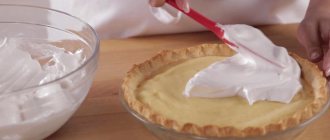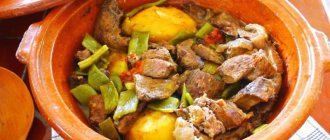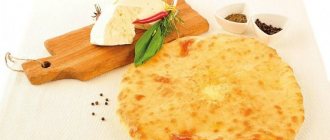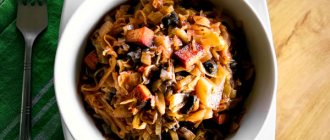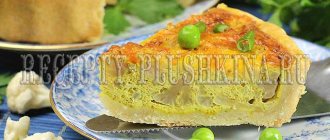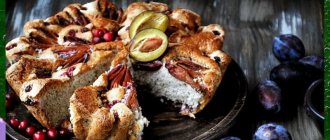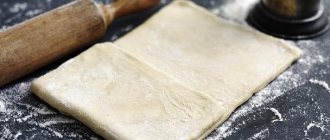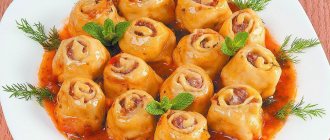Kneading process
To make the pie with cabbage and meat fluffy and soft, you should properly knead the yeast base. To do this, you need to pour the full-fat milk into a metal bowl, and then put it on the fire and warm it up a little until warm. Next, you need to dissolve granulated sugar in the liquid and add granulated yeast. In order for them to swell well, it is recommended to leave them aside for a quarter of an hour. After this, you should alternately add fine table salt, a beaten chicken egg, melted butter (butter) and wheat flour into the milk drink. It is advisable to add the last ingredient gradually, thoroughly kneading the dough. As a result, it should become soft and elastic, but at the same time tight and easy to stick to your hands.
A delicious cabbage pie will only turn out that way if the yeast base is kept in a warm place for at least 60 minutes. After all, it is during this procedure that the semi-finished product will take on the shape and consistency that is necessary for fluffy baking. By the way, it is recommended to first cover the dough in a bowl with a towel, and only then with a lid. After this, the pan should be placed near the radiator or in the sun if the weather is hot.
Necessary ingredients for filling
Cabbage and meat pie requires the use of a variety of ingredients. And which ones exactly, let’s look at them right now.
- soft white cabbage – 1.2 kg;
- white onions – 4 heads;
- large chicken eggs – 5 pcs. (one is necessary to lubricate the product);
- low fat milk – 900 ml;
- table salt, ground pepper – add at your personal discretion;
- lean pork – 500 g;
- boneless veal – 300 g;
- fresh dill and parsley - a small bunch;
- refined vegetable oil - for frying and greasing the baking sheet;
- fresh butter – 30 g (for greasing the finished pie).
Puff pastry pie with meat and cabbage
I would like to recommend a delicious pie made from yeast-free puff pastry, which is distinguished by its surprisingly juicy filling and delicate, thin dough.
- Cooking time: 50 minutes.
- The amount of ingredients is for 10 servings.
- Kitchen equipment you will need: a sieve, a bowl, a baking tray.
To prepare the dough we need to take:
| flour | 500 g |
| frozen margarine (butter) | 180 g |
| egg | 1 PC. |
| water (very cold) | 250 ml |
| vinegar |
For filling:
| cabbage | 400 g |
| tomato paste | 2 tbsp. l. |
| onion | 1 medium head |
| carrot | 1 PC. |
| meat (chicken or pork) | 400 g |
| vegetable oil | |
| curry seasoning (or to your taste) | |
| salt |
If you have chosen pork for this pie recipe, then it is better to choose the shoulder or hip part. The meat should not be too stringy. If, however, the selected meat turns out to be quite tough, then it can be marinated. To do this, you need to cut it into medium pieces, add salt and add either kefir or mineral water. After a few hours, the fillet will become softer; it should be washed under running water, then chopped as indicated in the recipe.
Preparation of puff pastry
Important! For this puff pastry recipe, all ingredients must be “ice cold,” just out of the refrigerator.
- Break an egg into “ice” water (from the refrigerator only), add 3 dessert spoons of vinegar (9%), and mix well.
- Pour the sifted flour directly onto the table.
- On a grater, grate a pile of flour into frozen margarine; you need to do this very quickly and try to coat it well with flour.
- Having made a funnel in the flour and margarine, pour in the prepared water with the egg and vinegar and begin to knead the dough, this must be done very quickly. The dough does not need to be kneaded well, but gradually introduce our mixture and fold the dough.
- The dough will crumble, but it should be folded, and if the dough feels dry, add a little water. Subsequently, it should turn out crumbly due to the fact that we do not knead it, but fold it.
Cooking the pie
- Stew the cabbage with onions, carrots and tomato paste until it is dry and does not spread.
- Cut the meat into pieces and boil until done.
- Combine the meat and cabbage in a container and mix well, taste for salt and add curry seasoning (or the seasoning you chose).
- We divide our puff pastry into 2 even parts. We roll out one part thinly with a rolling pin and place it on a large rectangular baking sheet, into which you first need to put parchment paper, greased with oil, slightly raising the sides of the dough.
- Spread the filling in an even layer around the entire perimeter of the baking sheet.
- Roll out the second part of the dough just as thinly.
- We cut out even long strips (you can make curly ones using a special knife).
- We decorate the pie with strips of dough, perpendicular to even squares, and attach the ends to the bottom layer of dough.
- Brush the top dough with egg. Place the baking sheet in an oven preheated to 180° and bake for 30 minutes.
- Remove the finished pie from the mold, grease it with a small amount of vegetable oil (refined) for shine and cover with a cotton towel so that the pie on top does not dry out.
This pie can be taken with you as lunch to work (school), or served on a holiday table with tea and simply as a salty main course.
Video recipe for puff pastry pie with meat and cabbage
We recommend taking a look at all the nuances of preparation in this video:
For meat gourmets, we present a puff pastry pie with meat.
Meat preparation process
A pie with meat and cabbage will turn out tender and tasty if you purchase only young and low-fat ingredients for the filling. We decided to take a soft piece of pork and some veal. They need to be washed, cleaned of various films, and then chopped in a meat grinder. After this, the finished minced meat must be placed in a saucepan and fried a little in vegetable oil with the addition of table salt and ground pepper. The meat should be quite crumbly and dry.
Recipe for Pies with minced meat and cabbage. Calorie, chemical composition and nutritional value.
Nutritional value and chemical composition of “Pies with minced meat and cabbage.”
The table shows the nutritional content (calories, proteins, fats, carbohydrates, vitamins and minerals) per 100 grams of edible portion.
| Nutrient | Quantity | Norm** | % of the norm in 100 g | % of the norm in 100 kcal | 100% normal |
| Calorie content | 186.8 kcal | 1684 kcal | 11.1% | 5.9% | 901 g |
| Squirrels | 6.9 g | 76 g | 9.1% | 4.9% | 1101 g |
| Fats | 10.7 g | 56 g | 19.1% | 10.2% | 523 g |
| Carbohydrates | 15.3 g | 219 g | 7% | 3.7% | 1431 g |
| Organic acids | 0.1 g | ~ | |||
| Alimentary fiber | 1.6 g | 20 g | 8% | 4.3% | 1250 g |
| Water | 64.2 g | 2273 g | 2.8% | 1.5% | 3540 g |
| Ash | 1.079 g | ~ | |||
| Vitamins | |||||
| Vitamin A, RE | 7 mcg | 900 mcg | 0.8% | 0.4% | 12857 g |
| Retinol | 0.006 mg | ~ | |||
| beta carotene | 0.026 mg | 5 mg | 0.5% | 0.3% | 19231 g |
| beta Cryptoxanthin | 0.12 mcg | ~ | |||
| Lycopene | 0.015 mcg | ~ | |||
| Lutein + Zeaxanthin | 0.513 mcg | ~ | |||
| Vitamin B1, thiamine | 0.059 mg | 1.5 mg | 3.9% | 2.1% | 2542 g |
| Vitamin B2, riboflavin | 0.087 mg | 1.8 mg | 4.8% | 2.6% | 2069 g |
| Vitamin B4, choline | 31.15 mg | 500 mg | 6.2% | 3.3% | 1605 g |
| Vitamin B5, pantothenic | 0.203 mg | 5 mg | 4.1% | 2.2% | 2463 g |
| Vitamin B6, pyridoxine | 0.16 mg | 2 mg | 8% | 4.3% | 1250 g |
| Vitamin B9, folates | 17.186 mcg | 400 mcg | 4.3% | 2.3% | 2327 g |
| Vitamin B12, cobalamin | 0.585 mcg | 3 mcg | 19.5% | 10.4% | 513 g |
| Vitamin C, ascorbic acid | 24.56 mg | 90 mg | 27.3% | 14.6% | 366 g |
| Vitamin D, calciferol | 0.044 mcg | 10 mcg | 0.4% | 0.2% | 22727 g |
| Vitamin E, alpha tocopherol, TE | 1.261 mg | 15 mg | 8.4% | 4.5% | 1190 g |
| gamma tocopherol | 0.011 mg | ~ | |||
| Vitamin H, biotin | 0.832 mcg | 50 mcg | 1.7% | 0.9% | 6010 g |
| Vitamin K, phylloquinone | 31.6 mcg | 120 mcg | 26.3% | 14.1% | 380 g |
| Vitamin RR, NE | 1.9208 mg | 20 mg | 9.6% | 5.1% | 1041 g |
| Niacin | 0.515 mg | ~ | |||
| Betaine | 2.396 mg | ~ | |||
| Macronutrients | |||||
| Potassium, K | 221.99 mg | 2500 mg | 8.9% | 4.8% | 1126 g |
| Calcium, Ca | 36.61 mg | 1000 mg | 3.7% | 2% | 2731 g |
| Silicon, Si | 0.667 mg | 30 mg | 2.2% | 1.2% | 4498 g |
| Magnesium, Mg | 15.01 mg | 400 mg | 3.8% | 2% | 2665 g |
| Sodium, Na | 189.63 mg | 1300 mg | 14.6% | 7.8% | 686 g |
| Sera, S | 34.5 mg | 1000 mg | 3.5% | 1.9% | 2899 g |
| Phosphorus, Ph | 74.1 mg | 800 mg | 9.3% | 5% | 1080 g |
| Chlorine, Cl | 271.27 mg | 2300 mg | 11.8% | 6.3% | 848 g |
| Microelements | |||||
| Aluminium, Al | 248.8 mcg | ~ | |||
| Bor, B | 96.2 mcg | ~ | |||
| Vanadium, V | 15 mcg | ~ | |||
| Iron, Fe | 1.093 mg | 18 mg | 6.1% | 3.3% | 1647 g |
| Yod, I | 2.01 mcg | 150 mcg | 1.3% | 0.7% | 7463 g |
| Cobalt, Co | 1.979 mcg | 10 mcg | 19.8% | 10.6% | 505 g |
| Manganese, Mn | 0.2029 mg | 2 mg | 10.1% | 5.4% | 986 g |
| Copper, Cu | 74.53 mcg | 1000 mcg | 7.5% | 4% | 1342 g |
| Molybdenum, Mo | 6.675 mcg | 70 mcg | 9.5% | 5.1% | 1049 g |
| Nickel, Ni | 6.517 mcg | ~ | |||
| Tin, Sn | 0.22 mcg | ~ | |||
| Rubidium, Rb | 23.8 mcg | ~ | |||
| Selenium, Se | 5.568 mcg | 55 mcg | 10.1% | 5.4% | 988 g |
| Strontium, Sr | 0.28 mcg | ~ | |||
| Fluorine, F | 19.78 mcg | 4000 mcg | 0.5% | 0.3% | 20222 |
| Chromium, Cr | 2.55 mcg | 50 mcg | 5.1% | 2.7% | 1961 |
| Zinc, Zn | 1.3476 mg | 12 mg | 11.2% | 6% | 890 g |
| Digestible carbohydrates | |||||
| Starch and dextrins | 11.462 g | ~ | |||
| Mono- and disaccharides (sugars) | 3.5 g | max 100 g | |||
| Glucose (dextrose) | 1.108 g | ~ | |||
| Maltose | 0.008 g | ~ | |||
| Sucrose | 0.508 g | ~ | |||
| Fructose | 0.704 g | ~ | |||
| Essential amino acids | 0.161 g | ~ | |||
| Arginine* | 0.407 g | ~ | |||
| Valin | 0.318 g | ~ | |||
| Histidine* | 0.176 g | ~ | |||
| Isoleucine | 0.287 g | ~ | |||
| Leucine | 0.498 g | ~ | |||
| Lysine | 0.416 g | ~ | |||
| Methionine | 0.141 g | ~ | |||
| Methionine + Cysteine | 0.09 g | ~ | |||
| Threonine | 0.234 g | ~ | |||
| Tryptophan | 0.04 g | ~ | |||
| Phenylalanine | 0.283 g | ~ | |||
| Phenylalanine+Tyrosine | 0.197 g | ~ | |||
| Nonessential amino acids | 0.38 g | ~ | |||
| Alanin | 0.368 g | ~ | |||
| Aspartic acid | 0.516 g | ~ | |||
| Hydroxyproline | 0.088 g | ~ | |||
| Glycine | 0.419 g | ~ | |||
| Glutamic acid | 1.267 g | ~ | |||
| Proline | 0.437 g | ~ | |||
| Serin | 0.296 g | ~ | |||
| Tyrosine | 0.192 g | ~ | |||
| Cysteine | 0.087 g | ~ | |||
| Sterols (sterols) | |||||
| Cholesterol | 33.66 mg | max 300 mg | |||
| Phytosterols | 0.25 mg | ~ | |||
| beta sitosterol | 7.8 mg | ~ | |||
| Fatty acid | |||||
| Trans fats | 0.507 g | max 1.9 g | |||
| Saturated fatty acids | |||||
| Saturated fatty acids | 3.5 g | max 18.7 g | |||
| 12:0 Lauric | 0.006 g | ~ | |||
| 14:0 Miristinovaya | 0.256 g | ~ | |||
| 15:0 Pentadecane | 0.041 g | ~ | |||
| 16:0 Palmitinaya | 1.973 g | ~ | |||
| 17:0 Margarine | 0.096 g | ~ | |||
| 18:0 Stearic | 1.052 g | ~ | |||
| 20:0 Arakhinovaya | 0.012 g | ~ | |||
| 22:0 Begenovaya | 0.013 g | ~ | |||
| Monounsaturated fatty acids | 4.211 g | min 16.8 g | 25.1% | 13.4% | |
| 14:1 Myristoleic | 0.071 g | ~ | |||
| 16:1 Palmitoleic | 0.317 g | ~ | |||
| 17:1 Heptadecene | 0.056 g | ~ | |||
| 18:1 Oleic (omega-9) | 3.732 g | ~ | |||
| 18:1 trans | 0.507 g | ~ | |||
| 20:1 Gadoleic (omega-9) | 0.004 g | ~ | |||
| Polyunsaturated fatty acids | 1.404 g | from 11.2 to 20.6 g | 12.5% | 6.7% | |
| 18:2 Linolevaya | 1.362 g | ~ | |||
| 18:3 Linolenic | 0.029 g | ~ | |||
| 18:3 Omega-3, alpha-linolenic | 0.018 g | ~ | |||
| 18:3 Omega-6, gamma-linolenic | 0.005 g | ~ | |||
| 20:4 Arachidonic | 0.011 g | ~ | |||
| Omega-6 fatty acids | 0.3 g | from 4.7 to 16.8 g | 6.4% | 3.4% |
The energy value of Pies with minced meat and cabbage is 186.8 kcal.
Primary Source: Created in the application by the user. Read more.
** This table shows the average levels of vitamins and minerals for an adult. If you want to know the norms taking into account your gender, age and other factors, then use the “My Healthy Diet” application.
Preparing vegetables and eggs
To prepare a tender and tasty flour product, you should use only soft (not imported) white cabbage. It must be chopped into thin strips, placed in a saucepan, poured with low-fat milk, salt and pepper and simmered over low heat until semi-soft. At the same time, the vegetable should retain some of its crunch.
Next, you need to peel the onions, cut them into half rings, place them in a frying pan and fry in refined vegetable oil until golden brown. After this, the finished cabbage should be placed in a colander, drained of all liquid, placed on the bulbs and cooked together under the lid for about half an hour (until the ingredients are completely soft).
Also, a pie with cabbage and meat involves the use of a product such as chicken eggs. They need to be hard-boiled and then chopped into small cubes or grated on a large grater.
After all the components are prepared, they need to be placed in one bowl and mixed (fried minced meat, white cabbage and onions, chicken eggs and herbs). If necessary, the aromatic filling can be additionally seasoned with salt and allspice.
Jellied pie with cabbage in a slow cooker
Owners of multicookers appreciate the convenience of this device; it is great for baking pies. A jellied pie is especially successful in a slow cooker. It is best to prepare it with already prepared boiled or baked meat.
- 500 gr. cabbage;
- 350 gr. boiled beef;
- 1 onion;
- 2 tablespoons of vegetable oil;
- 3 eggs;
- 100 gr. sour cream;
- 6 tablespoons (heaped) of flour;
- 2 teaspoons baking powder;
- salt and seasonings to taste.
Let's start by preparing the filling. Heat a frying pan with oil, fry the onion, then add the cabbage, salt, season and simmer over low heat until tender. When the vegetables are ready, add the boiled beef cut into cubes.
Advice! You can also prepare the filling in a slow cooker using the “fry” mode. Place the finished filling on a plate and let it cool, wash the bowl and wipe it dry.
Prepare the dough by mixing sour cream and eggs and mixing with a mixer. Then add baking powder, salt and flour. The mass will be thin. Place some of the dough into a greased bowl. We distribute the cabbage and meat filling on it. Pour in the remaining dough and place the bowl in the appliance.
Turn on “Baking” for 40 minutes, then, using a steaming basket, carefully turn the pie upside down. Turn on “Baking” again, this time for 20 minutes.
The process of forming a pie
By the time the cabbage and meat filling is completely ready, the yeast dough should have risen several times. Thus, you need to remove the base from the bowl, divide it into two unequal parts and roll out a larger piece into a layer, using wheat flour for dusting. Next, a sheet of dough up to 8 millimeters thick must be placed on a baking sheet or other large form, pre-greased. It should also be noted that at the base of the cake there must be sides measuring up to 4 centimeters. After this, you need to spread the entire filling in an even layer onto a baking sheet covered with dough, and then cover it with a second, but smaller part of the semi-finished yeast product. To finish, the edges of the base need to be joined together, weaving a beautiful braid, and the surface should be greased with beaten chicken egg.

